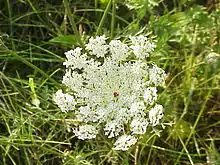Daucus
Daucus is a worldwide genus of herbaceous plants of the celery family Apiaceae of which the best-known species is the cultivated carrot. Daucus has about 25 species. The oldest carrot fossil is 1.3 Ma, and was found in Madeira island (Atlantic ocean)[1]
| Daucus | |
|---|---|
 | |
| Daucus carota | |
| Scientific classification | |
| Kingdom: | Plantae |
| Clade: | Tracheophytes |
| Clade: | Angiosperms |
| Clade: | Eudicots |
| Clade: | Asterids |
| Order: | Apiales |
| Family: | Apiaceae |
| Subfamily: | Apioideae |
| Tribe: | Scandiceae |
| Subtribe: | Daucinae |
| Genus: | Daucus L., 1753 |
| Species | |
|
See text | |
Description
Members of Daucus are distinguished within the family Apiaceae by their leaves which are 2–3 pinnatisect with narrow end sections. The genus primarily consists of biennial plants but also includes some annual plants and some perennial herbs. All Daucus have bristly stems. The inflorescences are umbels. The flowers are mostly white, with bracts and bracteoles. The petals may be pure white, reddish, pinkish or yellowish. They are emarginate above and have pointed, wrapped lobules. The petals are often unequal in size, with petals at the outermost edge of the inflorescence often being larger. The fruit is an ovoid to ellipsoidal schizocarp, cylindrical or compressed, with ciliate primary ribs and secondary ribs with a row of hooked spines.[2] Some species have a small pale or white edible taproot, similar to a radish, which may or may not be bitter in taste.
Ecology
Daucus pollination is carried out by insects, primarily: Lepidoptera, Coleoptera, Diptera, and Hymenoptera. It is a cosmopolitan genus with endemic species on most continents as well as on many islands and in isolated areas. The genus centre is in North Africa and Southwest Asia in the Temperate Zone. Prolonged dry or cold weather tends to retard growth in Daucus species, but the genus as a whole is evolutionarily adaptative to these conditions. Some Daucus species accumulate substantial resources in large underground taproots without impeding plant development. Native to Europe is the Carrot, with two subspecies: Wild Carrot and (subsp carota Daucus carota), a cultivated form of carrot, also called garden carrot.
Four members of the Daucus genus were examined to determine differences in isoenzyme patterns and plastid DNA. The four were: Daucus carota subspecies sativus cultivar Danvers, D. carota subsp. gummifer, D. capillifolius, and D. pusillus. Although only one form of HSDH (homoserine dehydrogenase) was present in each Daucus line, the rate of migration of HSDH from cv. Danvers was different from that of the others. Multiple isoenzymic forms of ADH were present in each Daucus cultivar. Comparison of endonuclease restriction fragment patterns from plastid DNAs digested by BamHI revealed only small differences between plastid DNAs of cv. Danvers and subsp. gummifer, whereas large differences were observed between cv. Danvers and D. pusillus plastid DNA patterns. No differences were found between cv. Danvers and D. capillifolius plastid DNA patterns when examined using eight different restriction enzymes. The data indicate that specific isoenzyme and organelle DNA restriction fragment patterns will be useful markers for precise identification of genomes of different Daucus species.[3]
Systematics
The genus comprises about 47 species divided into three sections.[4][5] The species include:
- Daucus aureus Desfontaines, yellow fruit's carrot, golden carrot
- Daucus broteri Tenore, Brotero's carrot
- Daucus aleppicus
- Daucus annuus
- Daucus arcanus
- Daucus aureus
- Daucus biseriatus
- Daucus blanchei
- Daucus broteri
- Daucus capillifolius
- Daucus carota L., Wild carrot
- Daucus crinitus
- Daucus decipiens
- Daucus della-cellae
- Daucus durieua Lange, Durieu's carrot
- Daucus edulis Lowe
- Daucus elegans
- Daucus glaberrimus
- Daucus glochidiatus (La Billardière) Fisch., C.A.Mey. & Avé-Lall.
- Daucus gracilis
- Daucus guttatus Sibthorp & Smith
- Daucus hirtus
- Daucus hochstetteri
- Daucus humilis
- Daucus incognitus
- Daucus insularis
- Daucus involucratus
- Daucus jordanicus
- Daucus littoralis Sibthorp & Smith
- Daucus mauritii
- Daucus melananthos
- Daucus microscias
- Daucus minusculus
- Daucus mirabilis
- Daucus montanus Humb. & Bonpl. ex Spreng.
- Daucus muricatus (L.) L.
- Daucus pedunculatus
- Daucus pumilus
- Daucus pusillus Michx., American wild carrot
- Daucus reboudii
- Daucus ribeirensis
- Daucus rouyi
- Daucus sahariensis
- Daucus setifolius
- Daucus tenuisectus
- Daucus tenuissimus
- Daucus virgatus
- Daucus yemenensis
References
- Góis‐Marques, Carlos A.; Nascimento, Lea de; Fernández‐Palacios, José María; Madeira, José; Sequeira, Miguel Menezes de (2019). "Tracing insular woodiness in giant Daucus (s.l.) fruit fossils from the Early Pleistocene of Madeira Island (Portugal)". Taxon. 68 (6): 1314–1320. doi:10.1002/tax.12175. ISSN 1996-8175.
- "Daucus carota (Carrot)". CAB International. 2019. Retrieved 10 November 2019.
- Benjamin F. Matthews; Kenneth G. Wilson; Lorin R. DeBonte (January 1984). "Variation in Culture, Isoenzyme Patterns and Plastid DNA in the Genus Daucus". In Vitro. 20 (1): 38–44. JSTOR 4292775.
- "Genus Daucus". Catalogue of Life. Retrieved 30 November 2020.
- Sáenz Lain C. 1981. "Research on Daucus L (Apiaceae)". Anales Jardin Botanico De Madrid. 37: 481–533.
The article is based on the following sources:
External links
- species list on the Germplasm Resources Information Network
- Daucus - Synonyms Index synonymique France (French)